小学英语教案:what—the—weather—like
- 格式:docx
- 大小:12.39 KB
- 文档页数:3
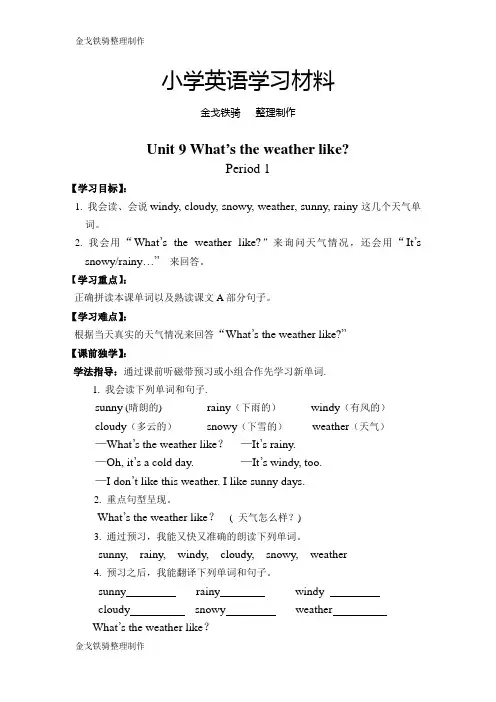
小学英语学习材料金戈铁骑整理制作Unit 9 What’s the weather like?Period 1【学习目标】:1. 我会读、会说windy, cloudy, snowy, weather, sunny, rainy这几个天气单词。
2. 我会用“What’s the weather like?”来询问天气情况,还会用“It’ssnowy/rainy…”来回答。
【学习重点】:正确拼读本课单词以及熟读课文A部分句子。
【学习难点】:根据当天真实的天气情况来回答“What’s the weather like?”【课前独学】:学法指导:通过课前听磁带预习或小组合作先学习新单词.1. 我会读下列单词和句子.sunny (晴朗的) rainy(下雨的)windy(有风的)cloudy(多云的)snowy(下雪的)weather(天气)—What’s the weather like?—It’s rainy.—Oh, it’s a cold day. —It’s windy, too.—I don’t like this weather. I like sunny days.2. 重点句型呈现。
What’s the weather like?( 天气怎么样?)3.通过预习,我能又快又准确的朗读下列单词。
sunny, rainy, windy, cloudy, snowy, weather4. 预习之后,我能翻译下列单词和句子。
sunny rainy windycloudy snowy weatherWhat’s the weather like?【我的疑问】:请你将预习中未能解决的问题和有疑问的地方写下来,待课堂上老师和同学探究解决。
【课堂合作探究】:1. 课堂导入师生用“I like a ... day. What do you like? ”谈论天气,复习上一课的天气单词。
2. 检查独学小组内自查独学情况,老师抽查。

湘鲁版小学英语教科书四年级下册第四单元Unit 4 What’s the weather like?一、教材内容分析:本节课是湘鲁版四年级英语下册第四单元What’s the weather like?的第一课时,是一篇新授课。
在英美国家,人们对于谈论天气有着特别的兴趣。
在他们看来,初次见面或在彼此不是很了解的情况下,谈论天气是最稳妥的办法。
英美人谈论天气,除个别情况是实实在在的想了解天气情况外,绝大部分情况都不是为了天气而谈论天气的,而是为了引入新的话题。
比如旅行的人们坐在车上,彼此互不认识,假如大家都默默地做着为面谈尴尬。
为了打破这种僵局,在英美人看来最方便、最安全的办法就是谈论天气。
因为对于天气这一话题,人人都可以发表见解,且不涉及他人私事,也不至于失礼或引起误解。
英国人尤其喜欢谈论天气,这与英国多变的天气情况有关,英国是世界上少有的几个天气多变的国家之一,往往上午还是阳光普照,下午就会大雨滂沱,一小时前还是晴空万里,一小时后就会大雾茫茫,因此天气成了英国人经常谈论的话题。
在我们国家在初学英语时,都会学习关于天气的句式。
事实上这也是我们自己也时常需要的一种语言调剂内容。
我们课本现在已经把关于天气的词语拓展的很宽了,例如:具体的教学内容是与天气有关的单词:hot, sunny,rainy, cold具体功能句型是询问有关天气的交际用语:What's the weather like?It's sunny/raining/hot/cold.二、学生情况分析:对于四年级学生来说,学习有关询问天气状况并不是一件难事,因为他们能够用已有的知识对所学的天气状况进行简单的交流与描述,但他们的头脑中缺乏对这些信息进行归类的意识,因此需要教师在这方面进行渗透和指导。
本班学生思维活泼,对英语学习有积极的热情,而且有较扎实的知识储藏。
但是班内也存在着两极分化的现象,有3-5名学生学习英语有一定的困难,需要在教学过程中给予更多的关注。
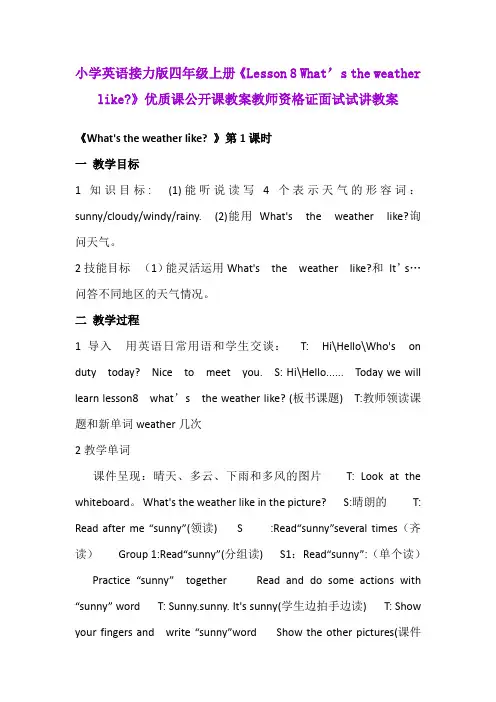
小学英语接力版四年级上册《Lesson 8 What’s the weather like?》优质课公开课教案教师资格证面试试讲教案《What's the weather like? 》第1课时一教学目标1知识目标: (1)能听说读写4个表示天气的形容词:sunny/cloudy/windy/rainy. (2)能用What's the weather like?询问天气。
2技能目标(1)能灵活运用What's the weather like?和It’s…问答不同地区的天气情况。
二教学过程1导入用英语日常用语和学生交谈:T: Hi\Hello\Who's on duty today? Nice to meet you. S: Hi\Hello...... Today we will learn lesson8 what’s the weather like? (板书课题) T:教师领读课题和新单词weather几次2教学单词课件呈现:晴天、多云、下雨和多风的图片T: Look at the whiteboard。
What's the weather like in the picture? S:晴朗的 T: Read after me “sunny”(领读) S :Read“sunny”several times(齐读)Group 1:Read“sunny”(分组读) S1:Read“sunny”:(单个读)Practice “sunny” together Read and do some actions with “sunny” word T: Sunny.sunny. It's sunny(学生边拍手边读) T: Show your fingers and write “sunny”word Show the other pictures(课件。

人教版小学英语六年级上册《Unit6》说课稿科任教师:丁腾一、说教材本单元学生学习的内容有:1).学会描绘和谈论天气.2).学会叙述在不同的天气背景下能做什么.3).学会表达现在进行和发生的动作.包含的语言知识如下:1. 重点词汇:(天气现象的词)rain、raining、snow、snowing、wind、windy、cloud、cloudy、cold、hot、warm、cool、humid;(词组)take photos、have a good time、on vacation、Thank you for···;(其它词)weather、terrible、pretty、beach、scarf、heat、relaxed.2. 重点句型是How’s the weather in Beijing? How’s it going? Whatare you /they doing?3. 语法项目是由how引导的特殊疑问句和现在进行时的用法.4. 情感目标是通过学习课文及句型操练,让学生学会谈论世界各大城市的天气状况以及描述在不同的天气下人们能做什么,了解外国的天文地理及日常习惯人们通常以谈论天气来引出其它话题,拉近彼此的距离,从而开拓学生的视野,增添学习英语的兴趣.5.对学生状况的分析:从学生现有的知识水平来看,在上一单元他们已学习了What are you/they doing? What is he/she doing? 这些现在进行时态的用法。
6.重难点的分析:重点在于How’s the weather? How’s it going?等由how引导的特殊疑问句;难点在与叙述在不同的天气下能做什么及写作能力的培养.二、教学方法1、说教法我把这个单元分为三课时,它们是词汇-句型操练课;听力课;写作课.我利用当时的实际天气状况来引入How’s the weather? It’s raining/windy/cloudy.这个句型的.出发点是以实际生活引入课堂,以旧知识引出新知识点,符合学生的认知能力的发展.然后利用一些图片来介绍sunny/snowing等几个大城市的天气现象,同学们熟悉了这些天气现象的词汇后,再进行句型操练和听力训练,然后进行写作训练叙述在不同的天气下能做什么等.充分利用直观教具图片、简笔画、录音机等教学手段,使学生在讨论中获得语言知识,在愉快的氛围中学习,学会问候关心同学,在交流中提高自己,在合作中创新.2、说学法1.大量发挥学生的潜能,指导学生在课前收集一些世界各大城市的天气状况图或不同天气下人们在做不同事情的图片.2.学会识别天气情况的图标和介绍各种天气状况.三、说教学过程第一课时:词汇-句型操练课Step 1. Leading-in1).利用真实情景和一些图片,用What’s the weather like today/inGuangzhou?It’s raining/windy/cloudy/cold/warm/cool/humid/snowing/sunny等描述天气状况的词.2).学生对于snowy/snowing, raining/rainy 等词的意义用法较难理解,我就利用顶尖教案上的“西游记外传-聊天”讲给学生听,目的在于增强target language(目的语)的掌握理解,并以此来增加学生的学习兴趣.Step 2.让学生试着将这几个表示天气状况的词和相应的图片配伍,了解更多描述天气状况的词,目的在于拓展词汇量.Step 3.出示天气简笔画的图,让学生写出sunny, cloudy, snowing, windy, raining,等词.主要是为了学生能识别一些天气图标Step 4.利用课前学生搜集到的图片让学生相互讨论:eg. S: How’s the weather in Guangzhou ?S: It’s sunny.Step 5.学生完成Section A. 1a部分,要求学生找出各图表示的天气状况的词,并相互对话练习.做此题的目的是为了让学生把本节课所学的知识点运用到实际生活中去.Step 6.听写,及时反馈,堂上巩固新词.1).How’s the weather today? It’s sunny.2).Cloudy/windy/raining/snowing/cold/humid/hot/cool/warmStep 7.Summary(let Ss say it out)这节课学习了有关天气状况的词以及以how引导的特殊疑问句的问答.Step 8. Homework.1). Copy the new words. 2). Make new conversations using the pictures that the students四.板书设计What’s the weather like ?How’s the weather?It’s sunny/snowing/raining/cloudy/windy.How’s it going?Not bad./Great/Pretty good.Unit6 It's raining (Section A 1a-1c)教案Teaching Aims and Demands1. Knowledge and Ability Objects(1)Key V ocabulary: raining, windy, cloudy, sunny, snowing,how’s=how is, weather, Moscow, Boston(2)Target Language: Hi! How’s the weather in Beijing? It’s sunny.(3)Train students’ listening skill(4) Train students’ communicative competence.2. Method Objects in Teaching.(1) Listening and talking methods. (2) Pair work.3. Moral Object:In the West, people like talking about the weather instead ofasking “Have you eaten?” or “Where are you going?”. It’s impolite to ask such questions in the west.Teaching Key Points1. Key vocabulary.2. Learn to talk about the weather using the target language.Teaching Difficulties1. Key vocabulary.2. Learn to talk about the weather using the target language.3. Train students’ listening skills4.Train students’ communicative competence.Teaching Aids:1. A computer for multimedia use. 2. A map of the world. Teaching ProceduresStep I. Greetings and Lead-inGuessing game, please guess what people are doing?He is playing the guitar. He is running.They are dancing. He is eating hamburgers.What is she doing? She is listening to music.And it is raining heavily in the picture.In this picture, we will learn to talk about weather.StepⅡNew words.Do you know any words about weather?sun snow wind rain cloudHow is the weather? sun, sunny, It’s sunny.How is the weather? cloud, cloudy, It’s cloudy.snow, snowy, It’s snowy.wind, windy, It’s windy.rain, rainy, It’s rainyFind out the rules: sun, sunny snow snowy wind windy rain rainy cloud cloudyThinking: Is it…? sunny, snowy, windy, rainy, cloudyStep Ⅲ.PracticeWhat’s the date today? It’s…How’s the weather? rainy, windy, cloudy, sunny, snowy,Step ⅣPairworkHow’s the weather? =What’s the weather like?Match 1a. 1a 2e 3d 4b 5cLook at the picture, where is it? Beijing, Shanghai, Moscow, Toronto, BostonStep V. Different cities different weatherHow’s the weather in Shanghai? It’s cloudy. Beijing sunnyStep V. Pair workHow’s the weather in …? It’s…Step VI. 1b ListenStep VII. Who is the best reporterGood morning, dear friends. Today is …Here is CCTV weather report! You can see, Beijing is rainy, Shenyang is …. Thank you for listening!Step VIII. Exercise1. It’s ____ (sun) today, but it’s ___ (wind)2. Look, what ____ they _____? (do) They _______ (play) tennis.3. There ___ (be) some milk in the glass.4. Can he ____ (go) shopping with me?5. Lucy ______ (have) lunch at school now.6.She usually _______(have) lunch at school.1. It’s eight o’clock. Jim’s father __TV.A. is watchingB. are watchingC. watchD. to watch2. ____ is the weather there? It’s windy.A. WhatB. HowC. What’sD. how3. ____ the weather like today? Cloudy.A. How’sB. What doesC. WhatD. What’s4. What’s the weather like today? ____A. It’s rain.B. It’s raining.C. It rainy.D. It’s wind.5. We want _________ this book now.A. readingB. am readingC. readD. to read6. That boy isn’t ____ the teacher.A. listenB. listensC. listeningD. listening to7. __ you __ the window? —Yes, I am.A. Do, cleanB. Is, cleaningC. Are, cleaningD. Do, cleaningStep X. Self summary1.V ocabulary about weather:2. Sentences :a. How to ask about the weather?b. How to ask about what others are doing?Step XI. Listen and sing a song (Rhythm of the rain)Blackboard DesignUnit6 It's raining(1)Key V ocabulary: raining, windy, cloudy, sunny, snowing,how’s=how is, weather, Moscow, Boston(2)Target Language: Hi! How’s the weather in Beijing? It’s sunny.课后反思:学生积极很高,兴趣浓厚,课堂气氛热烈。
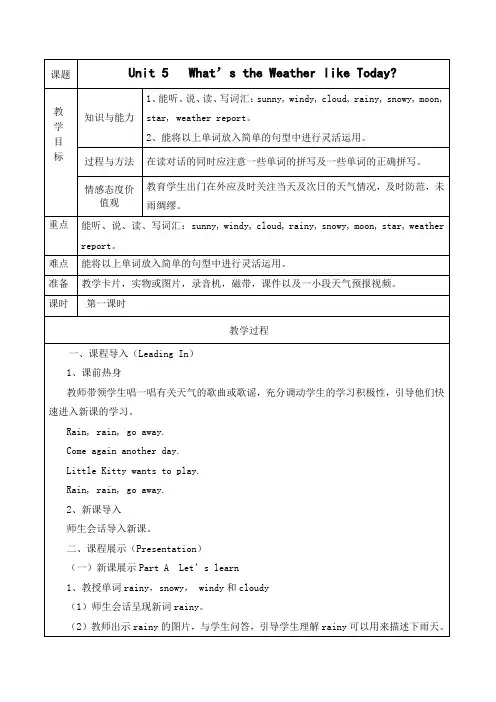
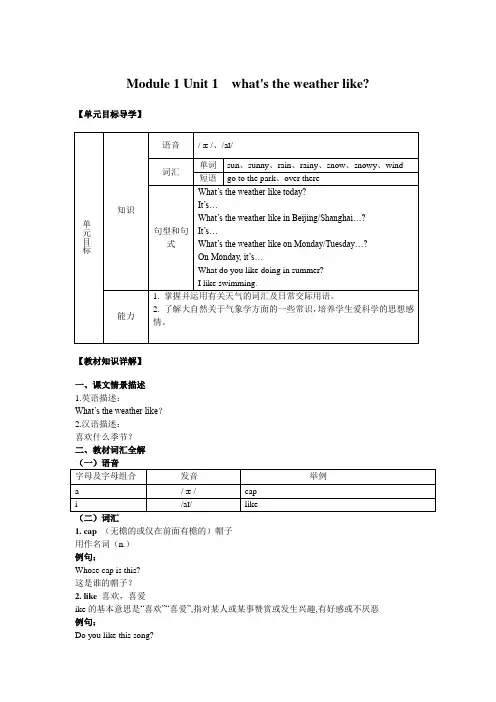
Module 1 Unit 1 what's the weather like? 【单元目标导学】【教材知识详解】一、课文情景描述1.英语描述:What’s the weather like?2.汉语描述:喜欢什么季节?二、教材词汇全解(二)词汇1. cap (无檐的或仅在前面有檐的)帽子用作名词(n.)例句:Whose cap is this?这是谁的帽子?2. like 喜欢,喜爱ike的基本意思是“喜欢”“喜爱”,指对某人或某事赞赏或发生兴趣,有好感或不厌恶例句:Do you like this song?你喜欢这首歌吗?3. sofa(长)沙发用作名词例句:The sofa are near the table.沙发靠近茶几。
4. sunny晴朗的sunny的基本意思是“阳光充足的,阳光明媚的”,引申可指“快活的,令人愉快的”。
例句:It's sunny today.今天天气晴朗。
5. take拿;拿走take是英语中含义最多,搭配能力最强的动词之一,基本意思是“拿,取,带,抓”,指用手取物、接受东西、把人或物移到某处。
例句:Don't take these books out of the library.不要把这些书拿出图书馆。
四、课文句型讲解1. What's the weather like? 天气怎么样?What's the weather like?表示询问天气的句型。
例句:What's the weather like here in summer?这里夏天天气怎么样?2. It's over there. It's on the sofa.在那儿,在沙发上。
over there的意思是在那边。
例句:It is over there.它在那边。
【相关话题拓展】Like的用法1. 用作动词(v.),意思为“爱,爱好,喜欢”,无进行时态,既表示对“人或者事物的真挚的感情”,又表示“对某事有着浓厚的兴趣﹑爱好”。
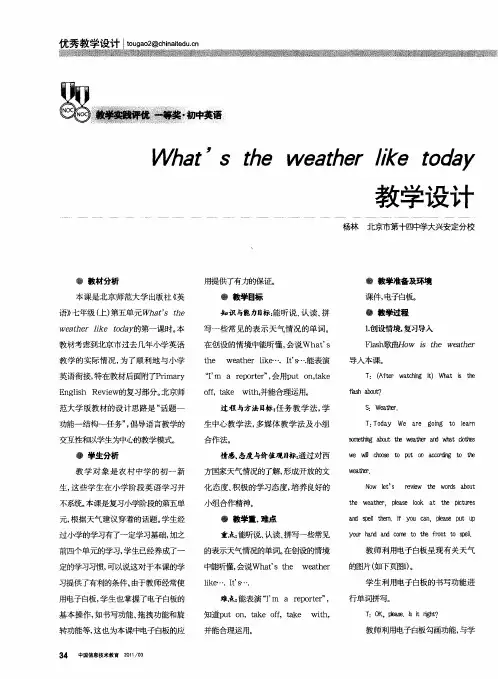
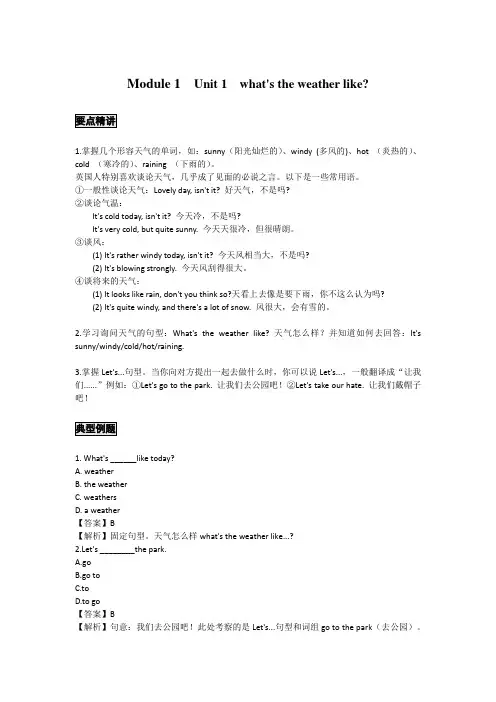
Module 1 Unit 1 what's the weather like?1.掌握几个形容天气的单词,如:sunny(阳光灿烂的)、windy (多风的)、hot (炎热的)、cold (寒冷的)、raining (下雨的)。
英国人特别喜欢谈论天气,几乎成了见面的必说之言。
以下是一些常用语。
①一般性谈论天气:Lovely day, isn't it? 好天气,不是吗?②谈论气温:It's cold today, isn't it? 今天冷,不是吗?It's very cold, but quite sunny. 今天天很冷,但很晴朗。
③谈风:(1) It's rather windy today, isn't it? 今天风相当大,不是吗?(2) It's blowing strongly. 今天风刮得很大。
④谈将来的天气:(1) It looks like rain, don't you think so?天看上去像是要下雨,你不这么认为吗?(2) It's quite windy, and there's a lot of snow. 风很大,会有雪的。
2.学习询问天气的句型:What's the weather like? 天气怎么样?并知道如何去回答:It's sunny/windy/cold/hot/raining.3.掌握Let's...句型。
当你向对方提出一起去做什么时,你可以说Let's...,一般翻译成“让我们......”例如:①Let's go to the park. 让我们去公园吧!②Let's take our hate. 让我们戴帽子吧!1. What's ______like today?A. weatherB. the weatherC. weathersD. a weather【答案】B【解析】固定句型。
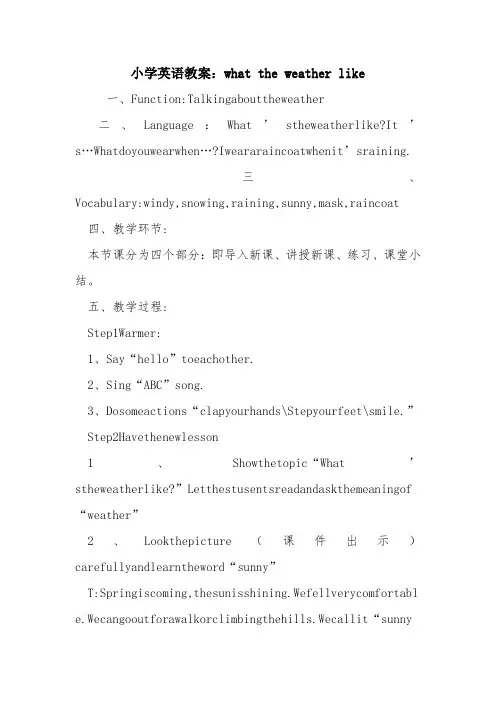
小学英语教案:what the weather like一、Function:Talkingabouttheweather二、Language:What’stheweatherlike?It’s…Whatdoyouwearwhen…?Iweararaincoatwhenit’sraining.三、Vocabulary:windy,snowing,raining,sunny,mask,raincoat四、教学环节:本节课分为四个部分:即导入新课、讲授新课、练习、课堂小结。
五、教学过程:Step1Warmer:1、Say“hello”toeachother.2、Sing“ABC”song.3、Dosomeactions“clapyourhands\Stepyourfeet\smile.”Step2Havethenewlesson1、Showthetopic“What’stheweatherlike?”Letthestusentsreadandaskthemeaningof “weather”2、Lookthepicture(课件出示)carefullyan dlearntheword“sunny”T:Springiscoming,thesunisshining.Wefellverycomfortable. Wecangooutforawalkorclimbingthehills.Wecallit“sunny”S:Readaftertheteather.(领读—齐读—分组读—单个读)T:Ask“What’stheweatherlike?”S:Answer“It’ssunny.”3、Practiceinpairs.4、Lookthepicture(课件出示)carefully.T:Afterspring,itcomessummer.“What’stheweatherlike?”S:Answer“It’shot.”(男女生分读—互问)T:Doyouwantsomewind?Pleaselistencarefully.What’ssound?5、Showthepicture(课件出示)Let’sthestudentslookthepicturecarefully.(raining)T:Pleasetellme“What’st heweatherlike?”S:下雨.T:Yes,raining.(readit.)S:Readit.(Boysandgirlsaskeachother.“What’stheweatherlike?”“It’sraining.”)6、Showthepicture(课件出示)Let’sthestudentslookthepicturecarefully.(cold)T:Pleasetellme“What’stheweatherlike?”S:It’scold.7、Showthepicture(课件出示)Let’sthestudentslookthepicturecarefully.(snowing)Step3Learnthepoem.T:ThispoemisverypopularinEngland.ItisknownbyalmostBriti shchildren.Nowlet’slearnittogether. (Readthepoemfor3times.)Step4Dismisstheclassbysaying“Good-bye”.Theexpectedre sponse is“Good-bye,MissLi.”。
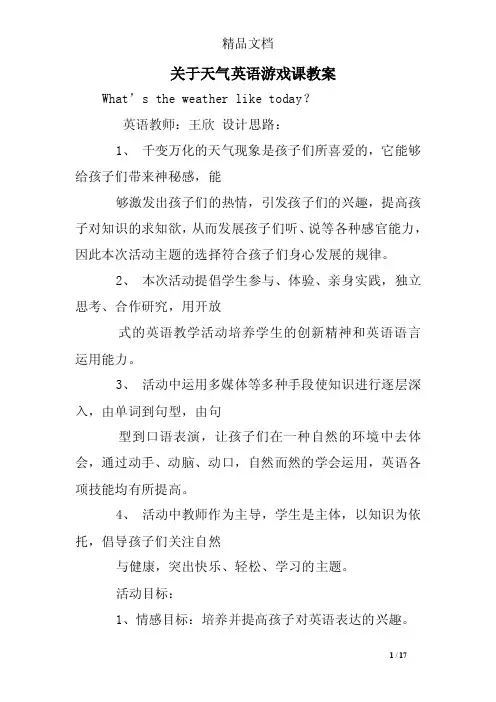
关于天气英语游戏课教案What’s the weather like today?英语教师:王欣设计思路:1、千变万化的天气现象是孩子们所喜爱的,它能够给孩子们带来神秘感,能够激发出孩子们的热情,引发孩子们的兴趣,提高孩子对知识的求知欲,从而发展孩子们听、说等各种感官能力,因此本次活动主题的选择符合孩子们身心发展的规律。
2、本次活动提倡学生参与、体验、亲身实践,独立思考、合作研究,用开放式的英语教学活动培养学生的创新精神和英语语言运用能力。
3、活动中运用多媒体等多种手段使知识进行逐层深入,由单词到句型,由句型到口语表演,让孩子们在一种自然的环境中去体会,通过动手、动脑、动口,自然而然的学会运用,英语各项技能均有所提高。
4、活动中教师作为主导,学生是主体,以知识为依托,倡导孩子们关注自然与健康,突出快乐、轻松、学习的主题。
活动目标:1、情感目标:培养并提高孩子对英语表达的兴趣。
2、能力目标:能够独立的进行英语思维,组织语言,并把所学知识运用于实际生活。
3、知识目标:掌握天气现象的英文单词,能够询问天气,并做简单的天气预报。
活动内容:1、词汇部分:各种关于天气现象的单词2、交际句型:What’s the weather like——It’s 活动重点:交际句型的运用活动难点:天气预报的播报环节活动方法:1、三段式法、直接听说法、演示法、游戏法活动准备:1、多媒体设备、天气课件2、关于天气现象的英语卡片活动课时:1课时活动班级:2班活动时间:2009年3月28日 18:30——19:10活动过程:一、 Warm upStep1:Greeting:Good evening,boys and girls!——good evening,Miss Wang。
Step2:Free talkSome questions:e.g. What are you doing?What do you do everyday?What colour do you like?What’s your favourite animal?How does your mother go to work?Do you like English or Chinese?设计意图:这是热身环节,以谈话这种自然交流的方式让孩子们走进英语课堂,开始英语思维。
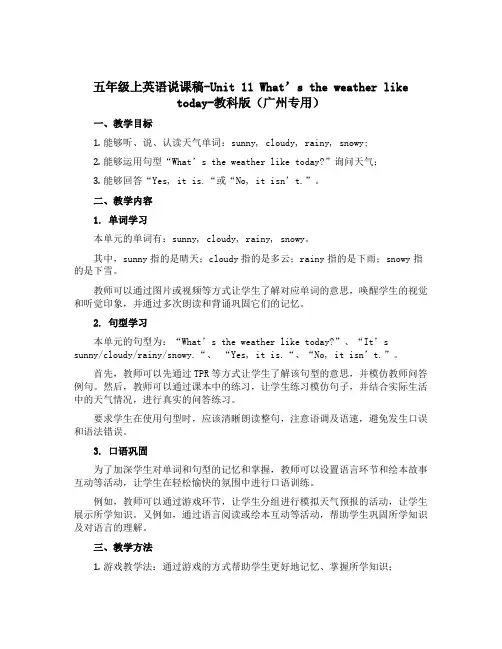
五年级上英语说课稿-Unit 11 What’s the weather liketoday-教科版(广州专用)一、教学目标1.能够听、说、认读天气单词:sunny, cloudy, rainy, snowy;2.能够运用句型“What’s the weather like today?”询问天气;3.能够回答“Yes, it is.“或“No, it isn’t.”。
二、教学内容1. 单词学习本单元的单词有:sunny, cloudy, rainy, snowy。
其中,sunny指的是晴天;cloudy指的是多云;rainy指的是下雨;snowy指的是下雪。
教师可以通过图片或视频等方式让学生了解对应单词的意思,唤醒学生的视觉和听觉印象,并通过多次朗读和背诵巩固它们的记忆。
2. 句型学习本单元的句型为:“What’s the weather like today?”、“It’ssunny/cloudy/rainy/snowy.“、“Yes, it is.“、“No, it isn’t.”。
首先,教师可以先通过TPR等方式让学生了解该句型的意思,并模仿教师问答例句。
然后,教师可以通过课本中的练习,让学生练习模仿句子,并结合实际生活中的天气情况,进行真实的问答练习。
要求学生在使用句型时,应该清晰朗读整句,注意语调及语速,避免发生口误和语法错误。
3. 口语巩固为了加深学生对单词和句型的记忆和掌握,教师可以设置语言环节和绘本故事互动等活动,让学生在轻松愉快的氛围中进行口语训练。
例如,教师可以通过游戏环节,让学生分组进行模拟天气预报的活动,让学生展示所学知识。
又例如,通过语言阅读或绘本互动等活动,帮助学生巩固所学知识及对语言的理解。
三、教学方法1.游戏教学法:通过游戏的方式帮助学生更好地记忆、掌握所学知识;2.情境教学法:通过创建语境和情境,帮助学生合理运用所学语言。
四、教学流程时间教学内容教学方式1min导入:歌曲《What’s the weather like today》TPR5min单词学习身体语言、多媒体10min句型学习TPR、教材引导10min句型扩展:问答练习情景引导10min组内互动:天气预报游戏式教学5min绘本故事互动情境引导4min总结梳理实物展示及扩展5min总结评估课堂氛围及小结五、教学资源1.多媒体设备(投影、音响等);2.绘本(《天气预报》等);3.实物(伞、雨靴等);4.课件、PPT等多媒体教学资源。
Unit 9、What’s the weather like ?一、教学目标:用What’s the weather like ? It's rainy . it's a cold day . It's windy , too .“I like / don’t like a ...day!”表达对不同天气的喜好。
掌握语言结构:What’s the weather like ?I like a sunny day.I don’t like rain.词汇:weather, like, windy, cloudy, snowy二、教学重点、难点:用What's the weather like ? It's rainy . it's a cold day .It's windy , too . “I like / don’t like a ...day!”谈论表达不同的天气。
掌握语言结构:What's the weather like ?I like a sunny day. I don’t like rain.三、教学准备:课件、教学磁带、单词卡片等四、教学步骤:Step 1 Warming up师生问候。
自由会话。
T: Do you like bananas/mangoes/lemons/...?游戏——Whispering (悄悄话)分组进行游戏。
老师将写有“Do you like bananas/mangoes/lemons/...?”的纸条分别发给每组最前一排的学生,该学生将这句话小声地向后传,以此类推,倒数第二排的学生大声说出所传的问题,最后一排的学生作答。
传得最快、完成得最好的一组为胜。
Step 2 Presentation and drill1、在黑板上画一个太阳的简笔画。
T: What’s this?S1: It’s the sun.T: Do you like the sun?S1: Yes, I do. / No, I don’t like the sun.T: What about you?S2: Yes. I do. / No, I don’tT(指着窗外的太阳或黑板上的太阳):Look at the sun. What's the weather like ?It’s a sunny day.板书并教学单词weather ,like和sunny2、在黑板上画雨的简笔画。
巧用媒体活化教材——新标准学生用书 Book 4 Module 1 Unit 2设计思路:根据教育部2号文件精神,小学开设英语课的目的是使学生获得基本的英语语言能力,形成积极向上的学习态度、灵活多样的学习策略以及跨文件交际意识和能力,为终身学习奠定基础。
在本堂课中,我充分考虑了小学生学习英语的心理、智力和思维特点以及课标精神,结合我校课题“利用现代化教学手段,深化小学英语教学”,充分发挥媒体优势,创设了真实有意义的“天气预报”活动,给学生搭建舞台,使其个性得到张扬。
同时,我根据教学的实际需要,创造性的对本单元教学内容进行重编,把它设计成了一个有意义的“环游地球”的故事,使教学在故事活动中得以完成,以“动”促说,以“动”促用,让学生在活动中学会英语,在轻松、愉悦中习得英语。
教学设计教学目标:一.知识目标:1.单词:rainy, snowy, windy, sunny, cloudy.2.城市名称:Beijing, London, Moscow, Singapore, Sydney.3.句子:It’s rainy. Open up your umbrella.It’s windy. Hold on to your hat.It’s sunny. Put on your sunglasses.It’s snowy. Put on your boots.It’s cloudy. Take your raincoat.Here’s the world weather.二.能力目标:1.让学生能够自由、活泼、创造性的使用所学的单词和句子。
2.培养学生们在日常生活中能够用这些单词和句子自由表达的能力。
三.情感目标:1.培养2.学生仔细听、认真观察、热切模仿、相互协作,友好竞争的态度,以及培养他们的民族自豪感和保护环境的意识。
教学重点:1.能够听、说、认读本课的重点单词:windy, sunny, cloudy, rainy, snowy。
三年级下册英语教案-Unit 9 What’s the weather like 第一课时湘少版(三起)一、教学目标1.知识目标:–掌握本单元单词和短语:weather, sunny, rainy, snow, cloudy, windy, hot, cold, warm等。
–能听、说、读、写句型“What’s the weather like?”和回答句型“It’s sunny/rainy/snowy/cloudy/windy/hot/cold/warm.”。
2.能力目标:–能用所学单词和句型描述天气情况。
–能在英语环境中自信地表达自己对天气的看法。
3.情感目标:–培养学生观察天气的好习惯。
–通过学习本单元内容,增强学生的环保意识,让他们从小开始爱护环境。
二、教学重难点1.教学重点:–听、说、读、写本单元的单词、短语和句型。
–能够描述不同天气的特征,培养观察和判断的能力。
2.教学难点:–与天气有关的词汇和句型的掌握。
–瞬间判断天气状况的能力。
三、教学准备1.教材:湘少版三年级英语下册。
2.教具:PPT,单词卡片。
3.学具:绘本《The Weather》。
1. Warming up1.Greet the students, and ask them some questions about the weather.2.Show some pictures of different types of weather (sunny, rainy, snowy, cloudy, windy) and ask the students to guess what each of them is.2. Presentation1.Teach the new words and phrases using PPT and word cards: weather, sunny, rainy, snow, cloudy, windy, hot, cold, warm.e PPT to introduce the sentence pattern “What’s the weather like?” and the corresponding responses: “It’ssunny/rainy/snowy/cloudy/windy/hot/cold/warm.”3.Model the sentence pattern and ask the students to repeat after you.3. Practice1.Ask the students to work in pairs to practice the sentence pattern by asking and answering each other’s questions about the weather.2.Call several pairs to act out their conversations in front of the class.4. Application1.Show the students some pictures of different types of weather. Ask them to describe what they see using the sentence pattern “What’s the weather like?” and the corresponding responses.e the word cards to create a word wall, and ask the students to identify the different types of weather and their related words.3.Read the storybook “The Weather” and ask the students to complete the corresponding worksheets.5. Extension1.Ask the students to use their new vocabulary to write a short paragraph about their favorite type of weather.2.Show some pictures of people engaging in different activities under different types of weather. Ask the students to discuss which activities are suitable for each type of weather.1.Recap the new words, phrases and sentence pattern.2.Review the types of weather and ask the students to describe them.3.Ask some students to share their paragraphs about their favorite types of weather.六、教学反思This lesson is designed to teach students about the different types of weather and how to describe them using the sentence pattern “What’s the weather like?” and the corresponding response. The students were engaged throughout the lesson, and they showed good understanding of the new vocabulary and how to use it in sentences. However, I think I could have incorporated more activities to reinforce the students’ learning, such as singing a weather-related song or playing a weather-related game. Overall, this lesson was successful in achieving its goals, and I look forward to teaching the next lesson in this unit.。
小学英语教案:what—the—weather—like
一、Function:Talkingabouttheweather
二、Language:What’stheweatherlike?It’s…Whatdoyouwearwhen…?Iweararaincoatwhenit’sraining.
三、Vocabulary:windy,snowing,raining,sunny,mask,raincoat
四、教学环节:
本节课分为四个部分:即导入新课、讲授新课、练习、课堂小结。
五、教学过程:
Step1Warmer:
1、Say“hello”toeachother.
2、Sing“ABC”song.
3、Dosomeactions“clapyourhands\Stepyourfeet\smile.”Step2Havethenewlesson
1、Showthetopic“What’stheweatherlike?”Letthestusentsreadandaskthemeaningof“weather”
2、Lookthepicture(课件出示)carefullyandlearntheword “sunny”
T:Springiscoming,thesunisshining.Wefellverycomfortable. Wecangooutforawalkorclimbingthehills.Wecallit“sunny”S:Readaftertheteather.(领读—齐读—分组读—单个读)
T:Ask“What’stheweatherlike?”
S:Answer“It’ssunny.”
3、Practiceinpairs.
4、Lookthepicture(课件出示)c
arefully.
T:Afterspring,itcomessummer.“What’stheweatherlike?”S:Answer“It’shot.”(男女生分读—互问)
T:Doyouwantsomewind?Pleaselistencarefully.What’ssound?
5、Showthepicture(课件出示)Let’sthestudentslookthepicturecarefully.(raining)
T:Pleasetellme“What’stheweatherlike?”
S:下雨.
T:Yes,raining.(readit.)
S:Readit.
(Boysandgirlsaskeachother.“What’stheweatherlike?”“It’sraining.”)
6、Showthepicture(课件出示)Let’sthestudentslookthepicturecarefully.(cold)
T:Pleasetellme“What’stheweatherlike?”
S:It’scold.
7、Showthepicture(课件出示)Let’sthestudentslookthepicturecarefully.(snowing)
Step3Learnthepoem.
T:ThispoemisverypopularinEngland.ItisknownbyalmostBriti
shchildren.Nowlet’slearnittogether. (Readthepoemfor3times.)
Step4
Dismisstheclassbysaying“Good-bye”.Theexpectedresponseis “Good-bye,MissLi.”。